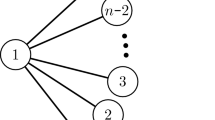Abstract
Let G=〈V, E, L〉 be a network with the vertex set V, the edge set E and the length vector L, and let T* be a prior determined spanning tree of G. The inverse minimum spanning tree problem with minimum number of perturbed edges is to perturb the length vector L to L+δ, such that T* is one of minimum spanning trees under the length vector L+δ and the number of perturbed edges is minimum. This paper establishes a mathematical model for this problem and transforms it into a minimum vertex covering problem in a bipartite graph G 0, a path-graph. Thus a strongly polynomial algorithm with time complexity O(mn 2) can be designed by using Hungarian method.
Similar content being viewed by others
References
Bondy, J.A., P. Murty, U.S., Graph Theory with Applications, London: The Macmillan Press, LTD., 1978.
Burton, D., P.L. Toint, “On the instance of the inverse shortest paths problem”, Math Program, Vol.53, pp45–61, 1992.
Burton, D., P.L. Toint, “On the use of an inverse shortest paths algorithm for recovering linearly correlated cost”, Math Program, Vol.63, pp1–22, 1994.
Huang, S., Z.H. Liu., “On the inverse problem of linear programming and its applications to minimum weigh perfect k-matching in bipartite graph”, European Journal of Operational Research, Vol.112, pp421–426, 1999.
Sokkaling, P.T., “The minimum cost flow problems: Primal algorithm and cost perturbations”, Unpublished Dissertation, Department of Mathematics, Indian Institute of Technology, India, 1995.
Sokkalingam, P.T., R.K. Ahuja, J.B. Orlin, “Solving inverse spanning tree problems through network flow techniques”, Operation Research, Vol.47, pp291–298, 1999.
Xu S., J. Zhang, “An inverse problem of the weighted shortest path problems”, Japanese J. Appl and Industrial Math, Vol.12, pp47–59, 1995.
Yang, C., J. Zhang., “Inverse maximum capacity problems”, OR Spektrum, Vol.20, pp97–100, 1998.
Zhang, J., Z.H. Liu, Z.F. Ma., “On the inverse problem of minimum spanning tree with partition constraints”, Mathematical Methods of Operations Research, Vol.44, pp171–187, 1996.
Author information
Authors and Affiliations
Additional information
Bangyi Li is a professor in the College of Economics and Management, Nanjing University of Aeronautics and Astronautics. He received a M.S degree in Operation Research from Shangdong University in 1988, and a Ph.D degree in Operation Research from Zhejiang University in 2001. Currently he is a postdoctoral in Graduate School of Management Science and Engineering, Nanjing University. His main research interests include system optimization, principal-agent theory and information economic.
Zhaohan Sheng is a professor in the Graduate School of Management Science and Engineering, Nanjing University. His main research interests include control theory and control engineering, game theory and management science.
Rights and permissions
About this article
Cite this article
Li, B., Sheng, Z. On the inverse minimum spanning tree problem with minimum number of perturbed edges. J. Syst. Sci. Syst. Eng. 12, 350–359 (2003). https://doi.org/10.1007/s11518-006-0140-8
Issue Date:
DOI: https://doi.org/10.1007/s11518-006-0140-8




